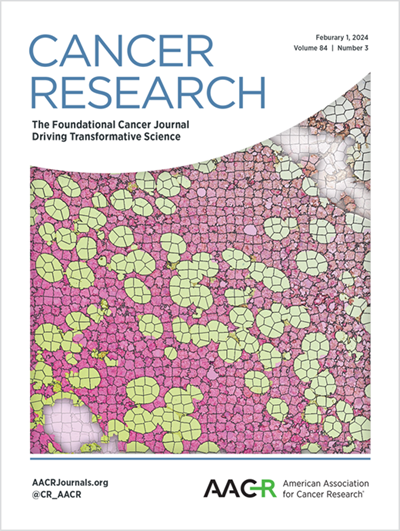Abstract CT092: A phase II basket trial of dual anti-CTLA-4 and anti-PD-1 blockade in rare tumors (DART) SWOG S1609: Vaginal cancers
IF 12.5
1区 医学
Q1 ONCOLOGY
引用次数: 0
Abstract
Background: SWOG S1609 Dual Anti-CTLA-4 & Anti-PD-1 blockade in Rare Tumors (DART) administered ipilimumab and nivolumab to patients with primary vaginal cancers. Methods: DART is a prospective, open-label, multicenter, multi-cohort phase II clinical trial of ipilimumab (1 mg/kg intravenously) every six weeks plus nivolumab (240 mg intravenously) every two weeks. The trial was carried out by the Early Therapeutics and Rare Cancers Committee (NCI/SWOG) and opened at >1000 sites. Cohort 33 included patients with vagina cancers only. The primary endpoint was objective response rate [ORR, confirmed complete and partial responses (CR and PR, respectively)] (RECISTv1.1), progression-free survival (PFS), and overall survival (OS); clinical benefit rate [CBR: ORR plus stable disease (SD)>6 months] and toxicity were secondary endpoints. Results: Seven evaluable patients (median age, 60 years; performance status 0-1; no prior exposure to immunotherapy) were analyzed (adenocarcinoma, N=3; squamous cell carcinoma (SCC) (N=2); small cell carcinoma and undifferentiated histology (N=1 each). The ORR was 29%: one, CR (undifferentiated) (lasting 14.8 months); one, PR (SCC) (lasting 45.2 months). The CBR was 43% (3/7 patients) (included one adenocarcinoma with 8 months SD). The 6-month PFS rate was 43%; median OS, 11.7 months. Five patients (71.4%) experienced an adverse event (AE); four, a grade 3-4 AE including one patient (14.3%) with elevated liver function tests leading to drug discontinuation. The most common AEs (any grade, at least possibly related to treatment) were cough (42.9%), fever (42.9%) and diarrhea (42.9%). Conclusion: Ipilimumab plus nivolumab in vaginal cancers resulted in an ORR of 29% and CBR of 43% including one CR, one PR and one patient with 8 months of stable disease; the longest response lasted 45.2 months. Further prospective studies exploring the role of both monotherapy and dual immunotherapy in vaginal cancers are warranted. Citation Format: Young K. Chae, Josie Czeskleba, Sandip P. Patel, Alex Menter, William Robinson, Nathaniel L. Jones, Murtuza Rampurwala, Aung Naing, Joseph M. Beck, Carolyn Moloney, Liam IL-Young Chung, Christine M. McLeod, Helen X. Chen, Elad Sharon, Sara Threlkel, Megan Othus, Christopher W. Ryan, Charles D. Blanke, Razelle Kurzrock. A phase II basket trial of dual anti-CTLA-4 and anti-PD-1 blockade in rare tumors (DART) SWOG S1609: Vaginal cancers [abstract]. In: Proceedings of the American Association for Cancer Research Annual Meeting 2025; Part 2 (Late-Breaking, Clinical Trial, and Invited s); 2025 Apr 25-30; Chicago, IL. Philadelphia (PA): AACR; Cancer Res 2025;85(8_Suppl_2): nr CT092.摘要 CT092:罕见肿瘤中抗CTLA-4和抗PD-1双重阻断的II期篮子试验(DART SWOG S1609:阴道癌
背景:SWOG S1609 Dual Anti-CTLA-4 & Anti-PD-1 blockade in Rare Tumors (DART) 为原发性阴道癌患者提供了伊匹单抗和尼夫单抗。研究方法DART是一项前瞻性、开放标签、多中心、多队列的II期临床试验,伊匹单抗(静脉注射1毫克/千克)每六周一次,加上尼妥珠单抗(静脉注射240毫克)每两周一次。该试验由早期治疗和罕见癌症委员会(NCI/SWOG)实施,在>1000个地点展开。队列 33 仅包括阴道癌患者。主要终点是客观反应率[ORR,分别为完全和部分反应(CR和PR)](RECISTv1.1)、无进展生存期(PFS)和总生存期(OS);次要终点是临床获益率[CBR:ORR加疾病稳定期(SD)>6个月]和毒性。结果:分析了7名可评估的患者(中位年龄60岁;表现状态0-1;既往未接受过免疫疗法)(腺癌,3人;鳞状细胞癌(SCC),2人;小细胞癌和未分化组织学,各1人)。ORR为29%:1例为CR(未分化癌)(持续14.8个月);1例为PR(SCC)(持续45.2个月)。CBR为43%(3/7例患者)(其中1例腺癌持续8个月)。6个月的PFS率为43%;中位OS为11.7个月。5名患者(71.4%)出现了不良事件(AE);4名患者为3-4级AE,其中1名患者(14.3%)肝功能检测结果升高,导致停药。最常见的不良反应(任何级别,至少可能与治疗有关)是咳嗽(42.9%)、发烧(42.9%)和腹泻(42.9%)。结论伊匹单抗联合尼妥珠单抗治疗阴道癌的ORR为29%,CBR为43%,其中包括1例CR、1例PR和1例8个月病情稳定的患者;最长反应持续了45.2个月。有必要进一步开展前瞻性研究,探索单药和双药免疫疗法在阴道癌中的作用。引用格式:Young K. Chae, Josie Czeskleba, Sandip P. Patel, Alex Menter, William Robinson, Nathaniel L. Jones, Murtuza Rampurwala, Aung Naing, Joseph M. Beck, Carolyn Moloney, Liam IL-Young Chung, Christine M. McLeod, Helen X. Chen, Elad Sharon, Sara Threlkel, Megan Othus, Christopher W. Ryan, Charles D. Blanke, Razelle Kurzrock.罕见肿瘤(DART)SWOG S1609:阴道癌双抗 CTLA-4 和抗 PD-1 阻断的 II 期篮子试验 [摘要]。In:美国癌症研究协会 2025 年年会论文集;第二部分(晚期突破、临床试验和特邀);2025 年 4 月 25-30 日;伊利诺伊州芝加哥。费城(宾夕法尼亚州):AACR; Cancer Res 2025;85(8_Suppl_2): nr CT092.
本文章由计算机程序翻译,如有差异,请以英文原文为准。
求助全文
约1分钟内获得全文
求助全文
来源期刊

Cancer research
医学-肿瘤学
CiteScore
16.10
自引率
0.90%
发文量
7677
审稿时长
2.5 months
期刊介绍:
Cancer Research, published by the American Association for Cancer Research (AACR), is a journal that focuses on impactful original studies, reviews, and opinion pieces relevant to the broad cancer research community. Manuscripts that present conceptual or technological advances leading to insights into cancer biology are particularly sought after. The journal also places emphasis on convergence science, which involves bridging multiple distinct areas of cancer research.
With primary subsections including Cancer Biology, Cancer Immunology, Cancer Metabolism and Molecular Mechanisms, Translational Cancer Biology, Cancer Landscapes, and Convergence Science, Cancer Research has a comprehensive scope. It is published twice a month and has one volume per year, with a print ISSN of 0008-5472 and an online ISSN of 1538-7445.
Cancer Research is abstracted and/or indexed in various databases and platforms, including BIOSIS Previews (R) Database, MEDLINE, Current Contents/Life Sciences, Current Contents/Clinical Medicine, Science Citation Index, Scopus, and Web of Science.
 求助内容:
求助内容: 应助结果提醒方式:
应助结果提醒方式:


